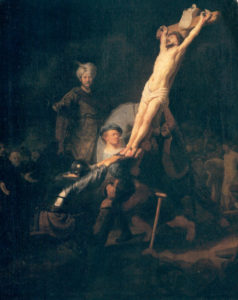One of the things I have come to discover in reading old books is there is nothing new under the sun. That when you take the time to discover what people have said in centuries past you realize how profound they really are. You see how relevant old things are. They help us see what is good, true and beautiful because it has always been so. The relevant of today is fickle and given to fads and trends. What was relevant centuries ago is in many ways more instructive for us as leaders. Do Kanye and Kim define relevance to our culture? I would argue no. They are the trendsetters perhaps but relevance true relevance goes deeper.
I’ll illustrate it with two things that have come across my path they last few weeks one is a picture the other a poem.
First is two paintings by the Dutch painter Rembrandt Harmenszoon van Rijn who was one of the most influential painters in Europe during the 1600’s. Though his life was marked by deep personal tragedy Rembrandt was able to see himself as a debtor to Christs forgiveness. We see the breadcrumbs of Rembrandt’s faith in how he did what no painter before him dared to do. He put himself in his own paintings and modeled for us the humility that comes with seeing yourself as you really are and seeing Christ as He truly is.
A couple of dramatic examples of this are his two famous painting of Christ. One is “The Raising of the Cross” the other is “The Decent from the Cross.”
 What is so powerful in The Raising of the Cross (pictured on the left) is Rembrandt places himself in his picture not as an innocent bystander but as a soldier complicit in the death of Christ. He paints a picture that says that he was guilty of the death of Christ. Rembrandt portrayed so powerfully in picture form what Paul tells us in Colossians 2:14
What is so powerful in The Raising of the Cross (pictured on the left) is Rembrandt places himself in his picture not as an innocent bystander but as a soldier complicit in the death of Christ. He paints a picture that says that he was guilty of the death of Christ. Rembrandt portrayed so powerfully in picture form what Paul tells us in Colossians 2:14
Because we broke God’s laws, we owed a debt—a debt that listed all the rules we failed to follow. But God forgave us of that debt. He took it away and nailed it to the cross.
As leaders, we must never forget in the message we preach that Jesus came to save sinners of whom we are foremost.
 In this second painting “The Decent of the Cross” we see the completion of the first painting. We see Rembrandt this time pictured in the blue standing weeping at the realization of the death he through his sin had made necessary. It is not enough to know that your sin put Christ on the cross. It is in the revelation of the sacrifice Christ made on your behalf that you see your desperate need that only a sinless spotless lamb can fulfill. Here we see Rembrandt overcome by his sin and Christ sinless sacrifice.
In this second painting “The Decent of the Cross” we see the completion of the first painting. We see Rembrandt this time pictured in the blue standing weeping at the realization of the death he through his sin had made necessary. It is not enough to know that your sin put Christ on the cross. It is in the revelation of the sacrifice Christ made on your behalf that you see your desperate need that only a sinless spotless lamb can fulfill. Here we see Rembrandt overcome by his sin and Christ sinless sacrifice.
The understanding of our sin and Christ sacrifice points us to the hope that the Gospel provides a hope in the resurrection. The third picture is actually a word picture in a poem by George Herbert who was a Welsh poet, Welsh poet, orator and Anglican priest and a contemporary of Rembrandt’s. He wrote a poem called “Time” that completes these two marvelous paintings by Rembrandt.
Christs coming hath made man thy debter,
Since by thy cutting he grows better.And in his blessing thou art blest:
For where thou onely wert before
An executioner at best;
Thou art a gard’ner now, and more,
An usher to convey our souls
Beyond the utmost starres and poles.
What Herbert is saying because Christ came and conquered sin and death we no longer need to fear because death is no longer our executioner it has become our gardener. Death serves only to plant us into real life, everlasting life. That wich used to be our end now only acts as a hinge that leads to the life we were always meant to live. That is good news that is what every heart needs. That is what hearts in the 1600’s needed and you and I need in a world out of control.
True relevance is not dictated by present fads but by timeless truth. Relevance speaks to what we need over percieved desires.
[Tweet “True relevance is not dictated by present fads but by timeless truth.”]

